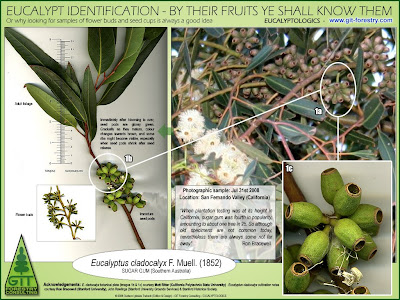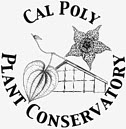By their fruits ye shall know them (IV)
Yet more tips on Eucalyptus Identification
Gustavo Iglesias Trabado 
GIT Forestry Consulting - Consultoría y Servicios de Ingeniería Agroforestal - www.git-forestry.com

GIT Forestry Consulting - Consultoría y Servicios de Ingeniería Agroforestal - www.git-forestry.com
We have previously seen in EUCALYPTOLOGICS how bark features alone can be misleading for accurate Eucalyptus species identification, showing examples of different bark types for the same eucalypt species and of similar bark types for different eucalypt species. We have also seen how in some cases just a small sample of flower buds can yield an accurate identification. Today we will see how just a distant photograph of seed cups (fruits) can yield a very promising species identification.
 Fig. 1: Example of fruit based diagnosis useful for accurate Eucalyptus species identification (Click image to enlarge)
Fig. 1: Example of fruit based diagnosis useful for accurate Eucalyptus species identification (Click image to enlarge)Our good friend Phil at Eucs-In-Habitat reported a mystery Eucalyptus growing in San Fernando Valley. Drew, the local observer in California, followed our recommended sequential observation process for eucalypt identification and took photographs of the overall outlook of the tree, its bark and of reproductive organs (blooming flowers, but more importantly, seed cups, the fruits).
 Fig 3: Blooming Eucalyptus cladocalyx in California. Image courtesy of Drew_2008. (Click image to enlarge)
Fig 3: Blooming Eucalyptus cladocalyx in California. Image courtesy of Drew_2008. (Click image to enlarge)These fruit samples, even if just photographed using a zoom, are what allows a very good bet as botanical identification of this Eucalyptus tree (see Fig. 1) by comparison to a botanical plate prepared with locally collected samples. And the solution was Eucalyptus cladocalyx, also known by its vernacular name Sugar Gum.
In addition, once again a look back in time paying attention to previous eucalypt experts can yield complementary data to support or reject an attempt of Eucalyptus species identification.
"When Eucalyptus plantation testing was at its height in California, sugar gum was fourth in popularity, amounting to about one tree in 25. So although old specimens are not common today, nevertheless there are always some not far away. (...) The tall smooth boles are free from lower branches and are in many cases recognizable on sight by warm-colored bark, with long vertical fissures and horizontal rows of dimples left over from insect bites years ago. On the ground you can pick up distinctive barrel-shaped fruit in clusters of up to 15 in number; these clusters in themselves suffice to give you confidence that you are under a sugar gum the next time you see them among the ground litter."
Eucalyptus species identification for this tree as E. cladocalyx makes sense then both in botanical but also in geographic and historical contexts. No doubt, once again we can see Eucalyptology is an interdisciplinary science.
Acknowledgements
To Matt Ritter for his efforts botanising Californian Eucalyptus and discovering Australian giants in the Sunny State. To John Rawlings and the team at Stanford Grounds Service for their effort not only preserving but also publicising online the botanical heritage of the campus. And to Ron Bracewell, possibly at this moment planting Eucalyptus and radio telescope antennas somewhere beyond our knowledge.
Also in Eucalyptologics...
 Example of "flower bud only" diagnosis useful for accurate Eucalyptus species identification
Example of "flower bud only" diagnosis useful for accurate Eucalyptus species identification
Example of "bark only" diagnosis misleading Eucalyptus species identification (Click image to enlarge)
 Examples of distinct flower bud characteristics in different Eucalyptus species. (Click image to enlarge)
Examples of distinct flower bud characteristics in different Eucalyptus species. (Click image to enlarge) Example of botanical sample gathering methodology for accurate Eucalyptus species identification (Click to enlarge)
Example of botanical sample gathering methodology for accurate Eucalyptus species identification (Click to enlarge) Different simultaneous stages of the reproductive cycle and eucalypt seed maturation process in a standing Snow Gum Eucalyptus tree.(Click to enlarge)
Different simultaneous stages of the reproductive cycle and eucalypt seed maturation process in a standing Snow Gum Eucalyptus tree.(Click to enlarge) After Eucalyptus seed collection: examples of Eucalyptus seedling nursery stock for afforestation (Click to enlarge)
After Eucalyptus seed collection: examples of Eucalyptus seedling nursery stock for afforestation (Click to enlarge)Find a local expert to ID your Eucalyptus
If you have an unknown eucalypt around and you are able to collect and photograph samples of the key organs needed for identification, do not hesitate contacting GIT Forestry Consulting.

If you are in the USA and find it easier to post fresh samples to a local expert, you can also contact Dr. Matt Ritter, resident eucalypt hunter at the California Polytechnic State University.
 Visit Cal Poly Plant Conservatory
Visit Cal Poly Plant Conservatory
 Subscribe to receive EUCALYPTOLOGICS via e-mail
Subscribe to receive EUCALYPTOLOGICS via e-mail
 Visit Cal Poly Plant Conservatory
Visit Cal Poly Plant ConservatoryContact us / Subscribe to Eucalyptologics
Subscribe to receive EUCALYPTOLOGICS via RSS
© 2008 Gustavo Iglesias Trabado. Please contact us if you want to use all or part of this text and photography elsewhere. We like to share, but we do not like rudeness.



No comments:
Post a Comment